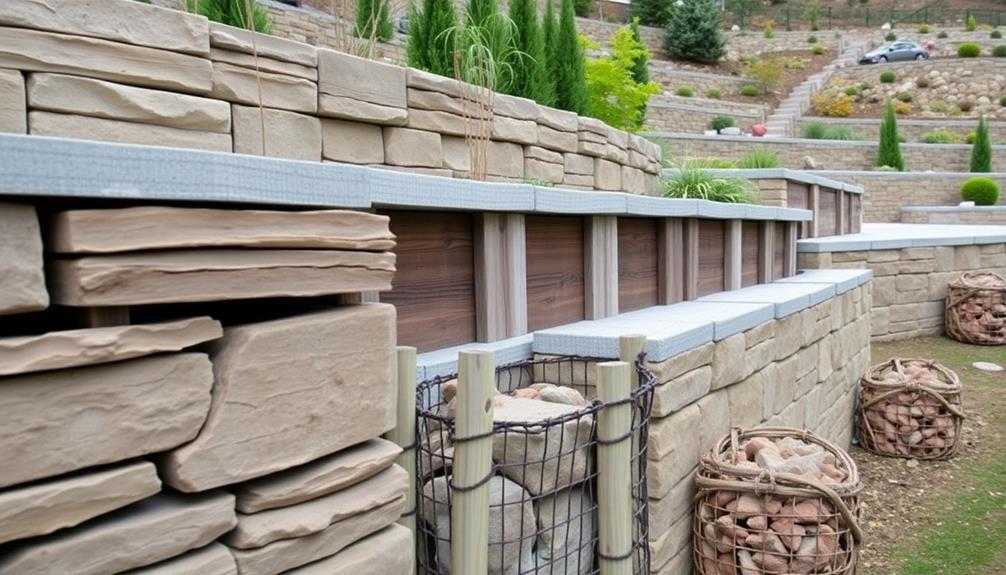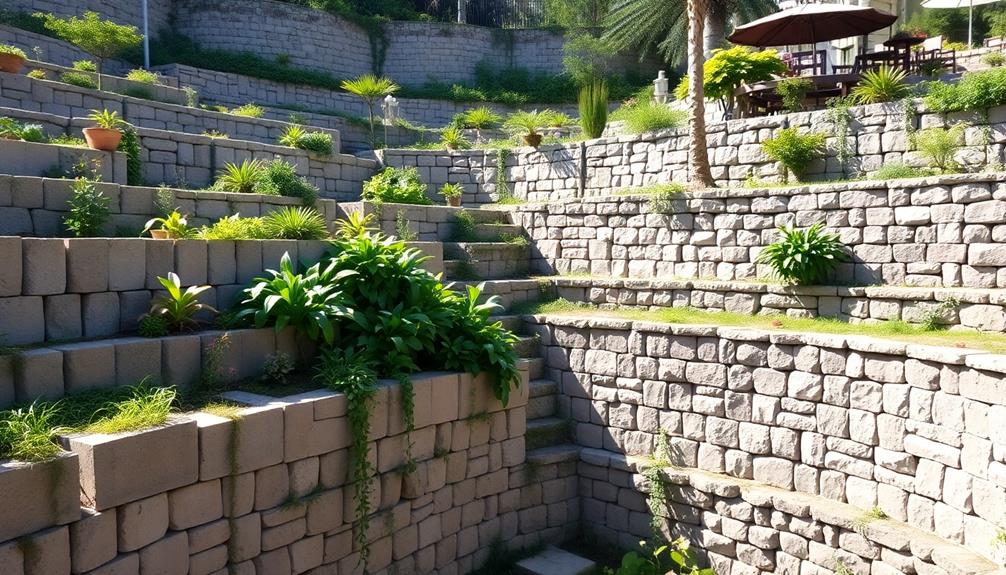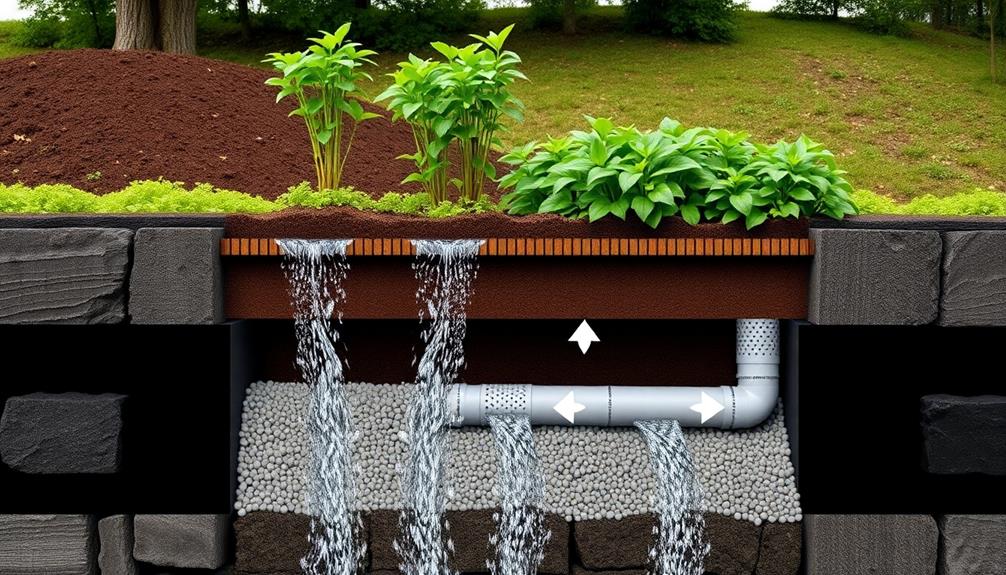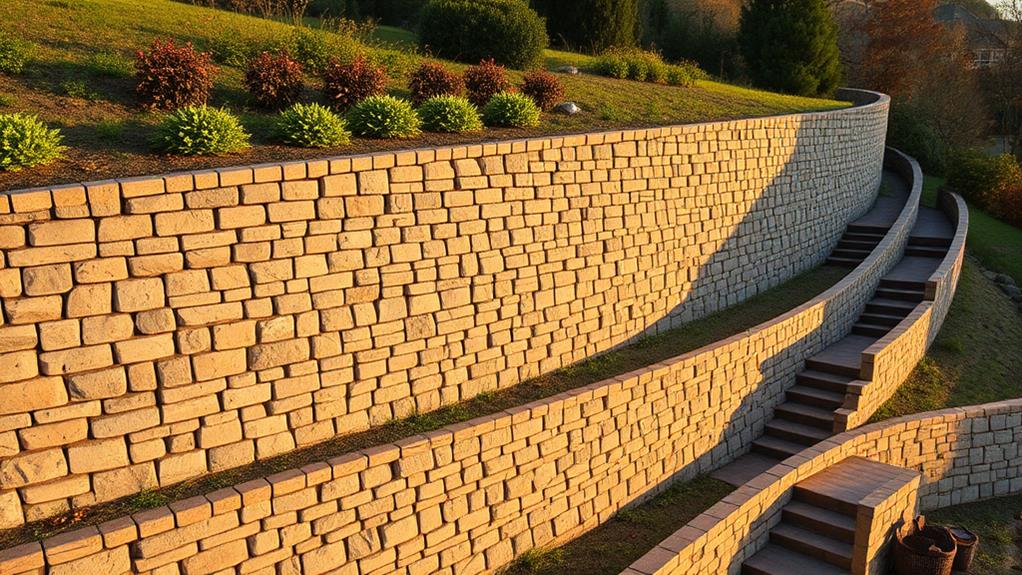Effective retaining wall design hinges on seven vital considerations. First, assess soil conditions to determine appropriate wall height and materials. Prioritize safety by adhering to local building codes and incorporating necessary features. Choose durable materials that withstand environmental factors and require minimal maintenance. Enhance aesthetics by aligning the design with the property's style and integrating complementary landscaping elements. Implement proper drainage systems to prevent water buildup and soil pressure. Consider site accessibility for efficient construction and maintenance. Finally, consult professionals to guarantee structural integrity and compliance with regulations. By following these tips, you'll create a functional, visually appealing, and long-lasting retaining wall that adds value to your property.
Table of Contents
ToggleWalls Contractor Highlights
- Consider soil conditions and consult professionals to ensure structural integrity and proper design.
- Prioritize safety by adhering to building codes and incorporating necessary safety features.
- Choose durable materials that can withstand local climate and environmental factors.
- Plan for proper drainage to prevent water buildup and maintain wall stability.
- Enhance aesthetics by aligning the wall's design with the property's style and incorporating complementary landscaping elements.
Material Selection for Walls

When selecting materials for retaining walls, several critical factors must be considered to guarantee the structure's longevity and effectiveness. The durability and weather resistance of the chosen materials play a paramount role in the wall's ability to withstand environmental stresses, while aesthetics and visual appeal contribute dramatically to the overall landscape design.
Boulder Walls, a Granite Company with over 20 years of experience, specializes in utilizing a range of materials including limestone, boulders, and granite for retaining walls in the Twin Cities area. Additionally, cost and availability factors influence the practicability of material choices, requiring careful balance between performance, appearance, and economic constraints.
Durability and Weather Resistance
The cornerstone of an effective retaining wall lies in its ability to withstand the elements and maintain structural integrity over time. When selecting materials for your retaining wall, it is paramount to consider their durability and weather resistance properties.
Concrete, natural stone, and engineered block systems are popular choices due to their robustness and longevity. These materials can endure freeze-thaw cycles, resist water penetration, and withstand the pressure exerted by soil and vegetation.
To boost durability, incorporate proper drainage systems into your wall design. This includes the use of backfill materials, such as gravel or crushed stone, and the installation of weep holes or drainage pipes. These features prevent water accumulation behind the wall, which can lead to hydrostatic pressure and eventual structural failure.
Additionally, contemplate applying sealants or waterproofing agents to further protect your wall from moisture damage. Regular maintenance, including inspections for cracks or shifts, and prompt repairs will guarantee your retaining wall remains structurally sound and aesthetically pleasing for years to come.
Aesthetics and Visual Appeal
Beyond durability and functionality, the aesthetic appeal of a retaining wall plays a significant role in enhancing the overall landscape design. The choice of materials for your retaining wall can dramatically influence its visual impact and integration with the surrounding environment.
Natural stone, such as granite or limestone, offers a timeless and elegant appearance that complements both traditional and contemporary landscapes. For a more rustic ambiance, weathered timber or reclaimed wood can provide a warm, organic feel that harmonizes with natural settings.
Concrete blocks, available in various textures and colors, offer versatility and can be customized to suit diverse architectural styles. Brick retaining walls exude a classic charm and can be coordinated with existing structures to create a cohesive look.
For those seeking a modern aesthetic, sleek metal panels or gabion walls filled with locally sourced stones can make a bold statement. When selecting materials, consider factors such as the wall's height, the property's architectural style, and the desired maintenance level to guarantee a harmonious blend of form and function that will enhance your outdoor space for years to come.
Cost and Availability Factors
Amidst the myriad considerations for retaining wall design, cost and availability of materials often play an essential role in decision-making. When selecting materials for retaining walls, it is pivotal to balance durability, aesthetics, and budget constraints. Common options include concrete blocks, natural stone, timber, and gabion baskets, each with its own price point and regional availability.
Concrete blocks are generally cost-effective and widely accessible, making them a popular choice for many projects. Natural stone, while often more expensive, offers unparalleled beauty and longevity, potentially justifying the higher initial investment.
Timber retaining walls can be economical in areas with abundant lumber resources but may require more frequent maintenance or replacement. Gabion baskets, filled with locally sourced stone, can provide a cost-effective solution in regions where suitable fill material is readily available.
It is indispensable to ponder not only the upfront costs but also long-term maintenance expenses when evaluating material options. Additionally, transportation costs can noticeably impact overall project expenses, particularly for materials not locally available. By carefully weighing these factors, designers can optimize their retaining wall solutions to meet both budgetary constraints and performance requirements.
Benefits

Retaining walls offer numerous benefits that extend beyond their primary function of holding back soil. These structures can drastically enhance property value and improve landscape aesthetics by creating visually appealing terraces, garden beds, or architectural features.
Boulder retaining walls provide a natural and long-lasting solution, with each unique boulder contributing to a one-of-a-kind appearance that boosts curbside charm. Additionally, retaining walls play an essential role in reducing soil erosion and increasing usable space on sloped properties, allowing homeowners to maximize their outdoor areas for various purposes such as patios, gardens, or recreational spaces.
Enhanced Property Value
A property's value can be markedly enhanced by the addition of a well-designed retaining wall. These structures not only serve functional purposes but also contribute significantly to the overall aesthetic appeal of a landscape.
By creating visually appealing terraces and maximizing usable space, retaining walls transform sloped or uneven terrain into valuable, level areas that can be utilized for gardens, patios, or additional living spaces. This transformation effectively increases the property's square footage, making it more attractive to potential buyers and investors.
Furthermore, a professionally constructed retaining wall demonstrates a commitment to property maintenance and improvement, signaling to prospective purchasers that the home has been well-cared for. The added curb appeal created by these architectural elements can set a property apart in a competitive real estate market.
Retaining walls also provide long-term benefits by preventing soil erosion and managing water runoff, which can protect the foundation and structural integrity of the main dwelling. This assurance of stability and longevity further contributes to the property's perceived value, as it reduces potential future maintenance costs for new owners.
Ultimately, the investment in a high-quality retaining wall design can yield substantial returns by elevating the property's market position and financial worth.
Improved Landscape Aesthetics
Improved landscape aesthetics stands as one of the primary benefits of incorporating retaining walls into a property's design. These structural elements not only serve functional purposes but also contribute considerably to the visual appeal of outdoor spaces.
By creating distinct levels and terraces, retaining walls add depth and dimension to otherwise flat landscapes, transforming mundane areas into visually engaging environments.
The versatility of retaining wall materials allows for seamless integration with existing architectural styles and natural surroundings. From rustic stone to sleek concrete, homeowners can select finishes that complement their property's aesthetic while enhancing its overall curb appeal.
In addition, these walls provide opportunities for creative landscaping, enabling the incorporation of diverse plant species at varying heights. This layered approach to vegetation creates a rich tapestry of textures and colors, fostering a more dynamic and compelling outdoor experience.
Additionally, retaining walls can be designed to include built-in seating areas, water features, or decorative lighting, further elevating the property's visual interest and functionality. By skillfully blending form and function, well-designed retaining walls not only solve practical challenges but also serve as striking focal points that elevate the entire landscape's aesthetic value.
Reduced Soil Erosion
Among the numerous benefits of retaining walls, reduced soil erosion stands out as a vital advantage for property owners and environmental stewards alike. These structures effectively combat the relentless forces of nature that continuously wear away valuable topsoil, preserving the integrity of landscapes and protecting ecosystems from degradation.
By strategically implementing retaining walls, property owners can considerably mitigate the loss of soil due to water runoff and wind erosion. These barriers act as formidable guardians, intercepting the flow of water and redirecting it away from vulnerable areas. This process not only preserves the structural stability of slopes and hillsides but also maintains the nutrient-rich topsoil essential for plant growth and biodiversity.
Furthermore, retaining walls play a pivotal role in preventing sedimentation in nearby water bodies, thus safeguarding aquatic habitats and maintaining water quality. By reducing erosion, these structures contribute to the overall health of the environment, fostering a sense of stewardship among property owners. Ultimately, the implementation of well-designed retaining walls serves as a hallmark of responsible land management, ensuring the longevity and sustainability of both natural and cultivated landscapes for generations to come.
Increased Usable Space
Transforming challenging terrain into functional areas, retaining walls offer property owners the tremendous benefit of increased usable space. By strategically constructing these structures, previously unusable slopes or uneven landscapes can be converted into valuable, level ground. This expansion of usable area allows for the creation of additional outdoor living spaces, gardens, or recreational zones, enhancing the overall functionality and value of the property.
Retaining walls effectively maximize land utilization by reclaiming space that would otherwise be inaccessible or impractical. In residential settings, this can translate to expanded patios, terraced gardens, or additional parking areas. For commercial properties, the increased space may accommodate larger buildings, expanded parking lots, or improved landscaping features. The versatility of retaining walls enables property owners to customize their newly created spaces to suit specific needs and preferences.
Moreover, the incorporation of retaining walls can remarkably improve the aesthetics of a property. By creating visually appealing terraces or multi-level landscapes, these structures add dimension and interest to otherwise flat or sloping terrain. This combination of functional improvement and aesthetic enhancement makes retaining walls a valuable investment for property owners seeking to optimize their land use and elevate their outdoor environments.
Drainage and Water Management Considerations

Effective drainage and water management are critical components of retaining wall design, ensuring the structure's longevity and stability. Proper water diversion techniques, such as surface grading and subsurface drainage systems, prevent hydrostatic pressure buildup behind the wall. The selection of appropriate backfill materials and the installation of weep holes further contribute to efficient water management, as illustrated in the following table:
| Technique | Purpose | Implementation |
|---|---|---|
| Water Diversion | Redirect surface and groundwater | Grading, swales, French drains |
| Backfill Selection | Promote drainage, reduce soil pressure | Use of granular, free-draining material |
| Weep Hole Installation | Allow water passage through wall | Strategically placed drainage openings |
Proper Water Diversion Techniques
Water management plays an essential role in the longevity and stability of retaining walls. Proper water diversion techniques are pivotal for preventing hydrostatic pressure buildup behind the wall, which can lead to structural failure and costly repairs. Implementing effective drainage systems guarantees that water is redirected away from the retaining wall, maintaining its integrity over time.
One of the most effective water diversion methods is the installation of a perforated drain pipe at the base of the wall. This pipe, typically surrounded by gravel, collects and channels water away from the structure. Additionally, incorporating a layer of free-draining backfill material, such as crushed stone or gravel, behind the wall allows water to flow freely downward to the drain pipe.
For added protection, a geotextile filter fabric can be installed between the native soil and backfill material, preventing fine particles from clogging the drainage system. Surface water management is equally important, with techniques such as grading the soil away from the wall and installing swales or catch basins to intercept runoff before it reaches the structure. By employing these proper water diversion techniques, retaining wall owners can dramatically extend the lifespan of their investment and ensure peak performance.
Backfill Material Selection
Building upon the importance of proper water management, the selection of appropriate backfill material is a key factor in ensuring effective drainage and long-term stability of retaining walls. The ideal backfill material should possess specific characteristics that promote water flow while maintaining structural integrity. Granular materials, such as clean, well-graded gravel or crushed stone, are typically preferred due to their excellent drainage properties and minimal compaction requirements.
When choosing backfill material, consider its particle size distribution, permeability, and compaction characteristics. A well-graded material with a range of particle sizes allows for optimal packing and stability. The permeability of the backfill should be sufficient to allow water to drain freely, preventing hydrostatic pressure buildup behind the wall. Additionally, the material should be free from organic matter, clay, or other fine particles that could impede drainage or lead to settlement over time.
It is fundamental to avoid using expansive soils or materials prone to frost heave in regions with freeze-thaw cycles. Incorporating a layer of geotextile fabric between the native soil and backfill material can further enhance drainage and prevent soil migration, ensuring the long-term performance of the retaining wall structure.
Weep Holes Installation
A retaining wall's longevity and performance hinge on proper drainage, with weep holes playing an essential role in this system. These strategically placed openings allow water to escape from behind the wall, preventing hydrostatic pressure buildup that could lead to structural failure. When installing weep holes, it is vital to ponder their spacing, size, and positioning to guarantee optimal effectiveness.
Typically, weep holes should be placed at intervals of 4 to 6 feet horizontally and 3 to 4 feet vertically, with a diameter of approximately 3 to 4 inches. The installation process involves embedding perforated pipes or creating openings during the wall construction. These drainage points should be connected to a gravel backfill layer, which acts as a filter and facilitates water movement.
To prevent soil erosion and maintain structural integrity, it is advisable to cover the weep hole openings with geotextile fabric or install pre-fabricated weep hole covers. Regular maintenance of weep holes is essential to guarantee they remain clear of debris and function properly throughout the wall's lifespan. By implementing a well-designed weep hole system, property owners can markedly extend the durability and stability of their retaining walls.
Walls Contractor FAQ
How Tall Can a Retaining Wall Be Without Requiring Engineering Approval?
The height limit for retaining walls without engineering approval typically varies by location. Generally, walls up to 3-4 feet tall can be built without professional oversight. However, it's always best to check local regulations for specific requirements.
What's the Average Lifespan of a Well-Constructed Retaining Wall?
A well-constructed retaining wall typically lasts 50-100 years, depending on materials and maintenance. Our community values durability, so investing in quality construction guarantees longevity. Regular inspections and proper care can extend its lifespan tremendously, benefiting us all.
Are Permits Required for Building Retaining Walls in Residential Areas?
Permit requirements for residential retaining walls vary by location. Generally, walls exceeding a certain height (often 3-4 feet) require permits. It's best to consult your local building department for specific regulations in your area.
How Often Should Retaining Walls Be Inspected for Potential Issues?
Retaining walls should be inspected annually, and after significant weather events. Regular checks help identify potential issues early, ensuring the safety and longevity of your wall. This proactive approach keeps your property secure and your community protected.
Can Retaining Walls Be Built on a Slope or Uneven Ground?
Yes, retaining walls can be constructed on slopes or uneven ground. Proper engineering and design are pivotal to guarantee stability and safety. Our team can help create a customized solution that addresses your specific terrain challenges effectively.







